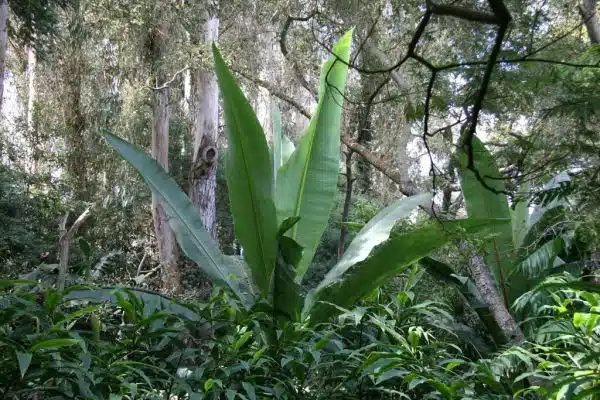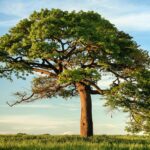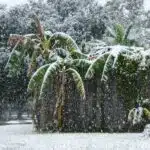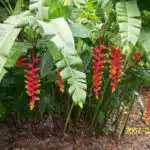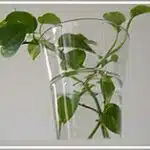Growing Abyssinian Banana (Ensete) Inside: A Complete Guide
As our world becomes more urbanized, the desire to grow food inside our homes has increased. The Abyssinian banana, also known as Ensete ventricosum, is an ideal plant for indoor cultivation due to its fast growth rate and low maintenance requirements. This article aims to provide a complete guide on growing Abyssinian banana indoors, from selecting the right cultivar to maintaining optimal growing conditions.
Abyssinian banana is a member of the Musaceae family, which includes both bananas and plantains. It is native to Ethiopia and is widely cultivated in East Africa as a staple food crop. The plant can reach up to 30 feet in height in its natural habitat but can be grown in containers indoors with proper care. With its large leaves and ornamental appearance, this plant can also serve as a beautiful decorative element in any home or office space.
Understanding The Abyssinian Banana Plant
Abyssinian banana, also known as Ensete ventricosum, is a plant species that belongs to the Musaceae family. It is commonly found in East Africa and Ethiopia, where it is considered an important staple food crop. The Abyssinian banana is a large herbaceous plant that can grow up to 10 meters tall and has a pseudostem composed of leaf sheaths.
Ensete cultivation techniques vary depending on the region and local traditions. In Ethiopia, for instance, farmers use a unique system called “enset culture,” which involves planting the crop in pits filled with cow dung and other organic matter. This technique helps to increase soil fertility while providing moisture retention for the plants during dry spells. In addition, farmers prune the leaves regularly to encourage new growth and maintain their health.
Abyssinian bananas are not only an important food crop but also have high nutritional value. They are rich in fiber, vitamins A and C, calcium, iron, and potassium. Moreover, they contain resistant starches that act as prebiotics in the gut, promoting healthy digestion and preventing diseases such as colon cancer. With these benefits in mind, it’s no wonder that many people are now interested in growing abyssinian bananas indoors as a way of ensuring a year-round supply of fresh produce.
Benefits Of Growing Abyssinian Banana Indoors
Understanding the Abyssinian Banana Plant has given us knowledge about its growth requirements and how to cultivate it. Now, let’s explore the benefits of growing Abyssinian Banana indoors. Indoor gardening is becoming increasingly popular, especially in urban areas where space is limited. With the right conditions and care, Abyssinian Banana plants can thrive indoors, providing an attractive and exotic addition to any indoor garden.
One of the main benefits of growing Abyssinian Banana indoors is that it allows year-round cultivation. This means you can enjoy fresh fruit throughout the year without having to worry about seasonal changes affecting your plant’s growth. Additionally, growing plants indoors reduces the risk of pests and diseases that commonly affect outdoor crops. This makes indoor gardening a safer option for those who want to avoid using pesticides.
Urban agriculture has become a necessity as more people are moving into cities, and food security becomes a concern. Growing Abyssinian Banana indoors can be a part of this movement towards sustainable living in urban areas. Not only do these plants provide food, but they also have other uses such as ornamental decoration or medicinal properties in some cultures. By cultivating these plants in our homes or apartments, we contribute to reducing our carbon footprint while enjoying their many benefits.
As we’ve seen, there are numerous reasons why growing Abyssinian Banana plants indoors is beneficial. However, choosing the right cultivar for indoor cultivation is crucial to ensure success in your indoor garden. In the next section, we will discuss how to select the best cultivar for your indoor environment and what factors you should consider when making your choice.
Selecting The Right Cultivar For Indoor Cultivation
When it comes to growing abyssinian banana, also known as Ensete, indoors, selecting the right cultivar is crucial. Ensete cultivars have varying characteristics that make them either suitable or unsuitable for indoor cultivation. One of the biggest challenges of indoor growing is providing enough light and warmth for the plant to thrive. Therefore, it’s important to select a cultivar that can tolerate low light conditions and doesn’t require too much heat.
Some Ensete cultivars are better suited for indoor growing than others. For example, the ‘Maurelii’ cultivar has dark red leaves that can add a beautiful touch of color to an indoor space. It’s also more tolerant of lower light levels than other Ensete cultivars. On the other hand, the ‘Montbeliardii’ cultivar has thinner leaves and requires more sunlight to grow properly. It may not be the best choice for indoor cultivation unless you have access to a sunny window or supplemental lighting.
Other characteristics to consider when selecting an Ensete cultivar for indoor cultivation include its size and growth rate. Some Ensete cultivars can grow up to 20 feet tall in just one season, which may be difficult to accommodate indoors. If you have limited space, consider selecting a smaller dwarf variety such as ‘Dwarf Cavendish’ or ‘Enano Gigante’. These varieties only reach about 6 feet in height and grow at a slower rate compared to other Ensete species.
Next section topic: Obtaining Seeds or Plantlets
Obtaining Seeds Or Plantlets
Propagation methods for Abyssinian banana (Ensete) include using seeds or plantlets. Seeds are typically produced after the plant has flowered and can be collected for propagation. However, Ensete plants grown from seed may vary in characteristics, making it difficult to get consistent results. On the other hand, plantlets can be obtained by dividing an established Ensete rhizome or through tissue culture techniques, resulting in plants with identical characteristics.
When obtaining seeds for propagation, it is important to choose fully matured and healthy fruits. These fruits should be left on the plant until they turn black before harvesting. The seeds should then be separated from the pulp and dried before planting. When using plantlets, care must be taken during transplanting to avoid damaging the delicate roots.
Regardless of the propagation method used, providing optimal growing conditions is critical for successful growth of Abyssinian banana plants. They thrive in warm climates with temperatures ranging between 20-30°C and require well-draining soil with a pH of 5.5-7.0. They also require frequent watering and high humidity levels.
Choosing the right container is an important step in ensuring proper growth of Abyssinian bananas indoors. Containers should be large enough to accommodate the size of the mature plant and have drainage holes at the bottom to prevent waterlogging. Additionally, containers made from porous materials such as terracotta allow for better air circulation around the roots and help regulate soil moisture levels.
Choosing The Right Container
When growing Abyssinian banana (Ensete) inside, one of the most important considerations is container size. A larger container size allows for more soil and root space, which then allows the plant to grow more vigorously. The type of soil used is also important for growing Abyssinian banana; the ideal soil type is one that is well-draining, high in organic matter, and with a slightly acidic pH. Finally, the container must also be able to provide adequate drainage, as too much water can cause root rot.
Container Size
Choosing the right container for growing abyssinian banana (ensete) is essential to ensure its healthy growth and development. Container size is one of the crucial factors that need to be considered when selecting a suitable pot for ensete. The container should be large enough to accommodate its root system and allow sufficient space for growth.
The size of the container is dependent on the maturity stage of the plant, as well as its expected growth rate. Typically, a mature abyssinian banana plant requires a minimum container size of 20-25 gallons. However, if you are planting ensete from seeds or young plants, you can start with smaller containers and gradually move them into larger ones as they grow bigger.
When selecting a container for abyssinian banana, it is essential to consider both the material and drainage requirements. The ideal material for ensente containers is porous clay or terracotta pots that allow proper air circulation and water drainage. Avoid using plastic containers as they tend to retain moisture, which can lead to root rot in your plant. It’s important to ensure that your pot has adequate drainage holes at the bottom to avoid waterlogging and promote good health in your plant.
In summary, choosing the right container size for your abyssinian banana (ensete) plays a vital role in ensuring healthy growth and development of your plant. The material and drainage requirements should also be considered when selecting an appropriate pot for ensete. A good rule of thumb is to choose a pot that accommodates its root system while allowing sufficient space for growth while ensuring proper drainage through adequate holes at the bottom.
Soil Type
When selecting a container for abyssinian banana (ensete), soil type is another important factor to consider. The right soil type can provide the necessary nutrients and support for your plant’s growth and development. Ensete plants prefer well-draining soil with a pH range between 5.5-6.5, which is slightly acidic. It’s important to avoid using heavy, clay soils that retain water and do not allow proper drainage, as this can lead to root rot and other plant diseases.
To create the ideal soil mix for growing abyssinian banana in containers, you can combine equal parts of peat moss, perlite, and vermiculite. This mixture provides excellent drainage while retaining some moisture for the plant’s roots to absorb. Additionally, incorporating organic matter such as compost or aged manure can add essential nutrients that your ensete plant needs to thrive.
When filling your container with soil mixture, ensure that it is loose and well-aerated. This allows air to circulate freely around the roots of your plant while preventing compaction that limits proper drainage. Remember to water your abyssinian banana regularly but avoid overwatering as it can lead to waterlogging and damage the roots of your plant.
In conclusion, choosing the right soil type when planting abyssinian banana in containers is crucial to ensure optimal growth and health of your ensete plant. A well-draining soil with a slightly acidic pH range between 5.5-6.5 is ideal for ensete growth. By combining equal parts of peat moss, perlite, and vermiculite along with organic matter such as compost or aged manure, you can create a nutrient-rich soil mix that promotes healthy growth in your abyssinian banana plant.
Soil Requirements
As we dive into the world of growing Abyssinian banana, it is crucial to understand the soil requirements for this plant. Soil composition plays a significant role in the growth and development of ensete. The soil should be well-draining with high organic matter content, allowing water to pass through easily while retaining enough moisture for healthy root growth.
The pH of the soil is also an essential factor that needs consideration when growing this plant. Ensuring the right pH level helps achieve optimal nutrient uptake and prevents deficiencies that could hinder growth. Abyssinian banana requires slightly acidic to neutral soil, with a pH range of 5.5 to 7.0 being ideal. It is advisable to test the pH level before planting and make any necessary adjustments by adding organic matter or using appropriate fertilizers.
In summary, getting the soil right is vital when it comes to growing Abyssinian banana successfully. Ensuring well-draining soil with ample organic matter content and maintaining optimal pH levels will provide a conducive environment for healthy growth and development of this plant. In the subsequent section, we will delve into watering and nutrient needs for ensate, which are just as important as getting the soil requirements right for optimal yields.
Watering And Nutrient Needs
Watering is essential in growing Abyssinian banana (Ensete) plants indoors. These plants are drought-tolerant, but they require regular watering to maintain their growth and overall health. The frequency of watering will depend on the environmental conditions and the size of the plant. Typically, it is best to water once a week during the growing season and reduce watering during winter when the plant goes dormant.
In terms of nutrient needs, Ensete plants require regular fertilization to thrive. Fertilization techniques should include a balanced blend of nitrogen, phosphorus, and potassium. A well-balanced fertilizer can help promote healthy foliage growth and aid in root development. It is recommended to fertilize every two weeks during the growing season and reduce fertilizing during winter months when plant growth slows down.
When caring for Abyssinian banana (Ensete) plants indoors, it is important to consider their lighting requirements. These plants require bright indirect light; direct sunlight can scorch their leaves. Supplemental lighting may be necessary in areas with low natural light levels. By providing proper lighting and maintaining adequate watering and fertilization techniques, you can ensure your Ensete plant thrives in an indoor setting.
Lighting Requirements
Watering and nutrient needs are crucial aspects of growing Abyssinian banana (Ensete) indoors. However, proper lighting is equally essential for the plant’s growth and development. Lighting requirements for indoor Ensete growth vary based on several factors such as light intensity, duration, and spectral quality. As a horticulturist, it is necessary to understand these factors to provide optimal lighting conditions for Ensete plants.
Artificial lighting options are widely used in indoor gardening due to their numerous advantages over natural light sources. LED (light-emitting diode) and fluorescent lights are the most commonly used artificial lighting sources for indoor Ensete growth. LED lights produce low heat, consume less energy, and can be customized based on the plant’s specific needs. On the other hand, fluorescent lights are cost-effective and readily available in the market. Horticulturists need to choose the right type of light source based on their budget, plant requirements, and other environmental factors.
While artificial lighting has its benefits, natural sunlight is still an excellent option for indoor Ensete growth if available. Natural sunlight provides a full spectrum of light that is beneficial to plants’ overall health and development. In situations where natural sunlight is not available or insufficient, horticulturists can supplement with artificial lighting sources like LEDs or fluorescent lamps. Regardless of the type of lighting chosen, it is essential to ensure that adequate light intensity and duration are provided consistently throughout the day.
Temperature and humidity considerations go hand in hand with proper lighting when growing Abyssinian bananas (Ensete) indoors. These environmental factors play a crucial role in determining plant growth rate and overall health. In this next section, we will discuss temperature and humidity requirements for indoor Ensete growth in detail to provide a comprehensive understanding of how these factors affect plant development indoors.
Temperature And Humidity Considerations
To successfully grow Abyssinian banana (Ensete) indoors, temperature and humidity are two crucial considerations to ensure healthy growth. The ideal temperature range for growing Ensete is between 60-80°F, with a slightly higher temperature during daytime and lower temperature at nighttime. Ensete is sensitive to cold weather; therefore, it is necessary to keep the plant away from drafts or air conditioning vents that can cause the temperature to drop below 60°F. To regulate the indoor temperature, using a space heater or an air conditioner may be necessary.
Humidity control is equally important as temperature regulation in growing Ensete indoors. The ideal humidity level for Ensete is between 50-70%. Low humidity levels can cause leaf damage and slow down plant growth, while excessively high humidity levels can lead to fungal diseases and root rot. One way to maintain optimal humidity levels is by using a humidifier or placing a tray filled with water near the plant. Misting the leaves can also help prevent them from drying out.
To provide the best growing conditions for Ensete, it is essential to maintain consistent temperature and humidity levels. Monitoring these conditions regularly will help identify any fluctuations that may affect plant growth. In addition, keeping the plant away from direct sunlight and providing adequate airflow will further promote healthy growth. In the next section, we will discuss pruning and training techniques that are vital for maintaining a healthy and productive Ensete plant indoors.
Pruning And Training Techniques
Pruning is a vital step in the growth of an Abyssinian banana (Ensete) as it encourages healthy growth and fruiting. Training the plant is likewise important, and can be done through staking, training upwards, weaving branches and trellising, amongst other methods. Pruning can be done through root pruning and tip pruning, and should be done with a specific frequency to keep plants in control. Training and pruning can also provide wind protection and help limit the size of the plant.
Pruning
As an expert in horticulture, one of the essential techniques that gardeners should learn is pruning. This technique is vital in maintaining the health and beauty of plants, including the Abyssinian banana, also known as Ensete. Pruning is necessary to control its growth and shape, remove damaged or diseased leaves, and promote new growth.
There are various pruning techniques that gardeners can use on their Abyssinian banana plant. One of which is removing old leaves by cutting them at the base using sharp and clean pruning shears. This technique will allow sunlight to penetrate better into the plant’s canopy, promoting healthy growth. Another technique is to trim the top of the plant to control its height or remove unwanted branches at their base.
Maintenance tips are crucial after pruning to ensure that your Abyssinian banana plant thrives well indoors. After trimming, it’s important to keep the soil moist but not wet and provide adequate light for optimal growth. Regularly fertilizing with a balanced fertilizer will also help maintain the plant’s health and vigor. By following these pruning techniques and maintenance tips, you can ensure that your Abyssinian banana plant continues to thrive inside your home or office without outgrowing its space.
In conclusion, pruning is an essential technique for maintaining healthy growth in your Abyssinian banana plant indoors. Knowing various techniques such as removing old leaves and controlling height will help you achieve optimal results. Coupled with proper maintenance tips such as providing adequate lighting and regular fertilization, your Ensete will undoubtedly flourish even in indoor settings.
Training
As a horticultural expert, pruning is essential for maintaining the health and beauty of plants. However, pruning alone may not be enough to achieve optimal results. Training is another technique that gardeners can use to shape their Abyssinian banana plant and promote healthy growth.
Training involves manipulating the plant’s growth pattern by tying or bending its branches, stems, or trunk. This technique is necessary to control the plant’s size and shape within an indoor space. By training the plant early on, you can direct its growth rate and prevent it from outgrowing its container.
There are various training techniques that you can use on your Abyssinian banana plant indoors. One of which is staking, where you insert a stake next to the plant’s stem to keep it upright. Another technique is bending, where you bend the stem or trunk gently and tie it down with soft twine or wire. These techniques will help you achieve a well-balanced and aesthetically pleasing Ensete while promoting healthy growth.
Pest And Disease Control Measures
Effective pest and disease control measures are crucial for ensuring the healthy growth of abyssinian banana plants. One approach is to adopt integrated pest management (IPM) strategies that combine various control methods to minimize the use of chemical pesticides. IPM involves monitoring and identifying potential threats, implementing preventive measures such as improving plant nutrition and soil structure, introducing natural predators or parasites, and applying selective pesticides only when necessary.
Natural remedies can also be used in conjunction with IPM strategies to combat pests and diseases. For instance, neem oil is an effective natural pesticide that can repel aphids, spider mites, and whiteflies. Similarly, garlic extract can deter thrips, while chrysanthemum-based pyrethrin spray can control a wide range of pests. Alternatively, planting companion crops such as marigolds or basil can provide natural barriers against pests through their strong scent or insect-repelling properties.
To prevent the spread of diseases among abyssinian banana plants, it is important to observe good hygiene practices such as pruning infected leaves or stems and disposing of them properly. Additionally, maintaining proper air circulation around the plants by spacing them adequately can reduce the risk of fungal infections such as black leaf streak disease. Regularly fertilizing the plants with organic matter can also boost their immunity against diseases.
In summary, adopting integrated pest management strategies and using natural remedies can help control pests and diseases in abyssinian banana plants without relying solely on harmful chemical pesticides. With good management practices in place, growers can minimize crop losses due to pests or diseases and ensure a healthy harvest of fruits from their ensete plants.
Harvesting The Fruit
Pest and disease control measures are crucial in ensuring the successful growth of Abyssinian banana inside. However, planting techniques also play a significant role in increasing the yield of this fruit. First, it is important to choose a suitable location that provides adequate sunlight and has well-draining soil. The soil should be enriched with organic matter before planting to ensure proper growth.
After planting, regular watering and fertilization are necessary for the plant’s survival. Mulching around the base of the plant can help retain moisture and suppress weeds. Additionally, pruning dead or damaged leaves can prevent the spread of diseases and pests. Proper management practices such as these can improve the quality and quantity of fruit produced by Abyssinian banana plants.
Post-harvest handling is also important in maintaining the quality of harvested fruit. After harvest, bananas should be stored in a cool, dry place away from direct sunlight to prevent spoilage. It is best to handle bananas with care to avoid bruising or damaging them during transportation or storage. By following these post-harvest handling practices, farmers can increase their profits by selling high-quality fruits that meet market demands.
To propagate Abyssinian banana plants, there are various techniques that horticulturists use to ensure successful plant reproduction. One common method is through suckers, which are small shoots that grow from the base of established plants. Suckers can be carefully removed from the parent plant and replanted to produce new plants. Other propagation techniques include tissue culture and seed propagation methods. These methods vary depending on factors such as cost, time required for propagation, and desired outcomes for production purposes.
Transitioning into the subsequent section about propagation techniques: By understanding these different propagation techniques, horticulturists can successfully reproduce Abyssinian banana plants for increased production and profitability.
Propagation Techniques
Propagating abyssinian banana (ensete) from seed requires the seeds to be soaked in warm water overnight prior to planting, and the soil needs to be kept moist to promote germination. Propagation from cuttings is a much faster process and involves selecting healthy, mature stems and cutting them into sections. These sections should then be planted in a sterile medium that has been treated with a rooting hormone and maintained at a warm temperature to promote root formation. For maximum success, it is important to select healthy and mature plants for propagation and provide the right conditions during the process.
Propagation From Seed
Starting a new plant from seed can be an exciting and rewarding experience for any gardener or horticulturist. Growing Abyssinian Banana (Ensete) indoors from seed is a fascinating process that requires patience, dedication, and careful attention to detail. The germination process of Abyssinian Banana seeds is relatively straightforward if the right conditions are met.
To begin with, it’s essential to start with fresh seeds that have been harvested from healthy fruit. Once you have obtained your seeds, it’s time to prepare them for planting. Soak the seeds in water for about 24 hours before sowing them in sterile potting soil. Keep the soil moist but not waterlogged and place the container in a warm, well-lit area. Within two to four weeks, you should see sprouts emerging from the soil.
Once your Abyssinian Banana seeds have germinated and sprouted into seedlings, you need to make sure they receive adequate care to thrive. Careful watering is critical at this stage since too much water can cause root rot while too little can stunt growth or kill the plants altogether. Provide your seedlings with plenty of bright light by placing them near south-facing windows or under grow lights for at least eight hours per day. Also, make sure to keep them away from cold drafts or extreme temperatures.
In conclusion, propagating Abyssinian Banana (Ensete) from seed can be an enjoyable way to expand your indoor garden collection while also learning more about this fascinating species. However, it’s essential to follow proper germination procedures and provide adequate care during the seedling stage to ensure that your plants grow into healthy specimens that will provide years of enjoyment and satisfaction. With patience and dedication, anyone can successfully propagate these beautiful plants indoors!
Propagation From Cuttings
Propagation from cuttings is another effective way to expand your indoor garden collection of Abyssinian Banana (Ensete). This propagation method involves taking a stem cutting from a mature plant and rooting it in soil or water. One of the benefits of ensete cultivation through this method is that it allows you to create new plants that are identical to the parent plant, ensuring consistent growth patterns and characteristics.
When propagating Abyssinian Banana from cuttings, it’s important to choose a healthy, disease-free stem with at least two nodes. Remove any leaves from the lower half of the cutting and dip the base in rooting hormone before planting it in moist soil or placing it in water. Keep the cutting in a warm, humid environment with bright but indirect light until roots begin to form. Once roots have formed, gradually acclimate the young plant to its final growing location.
Proper care for ensete cuttings involves providing them with ample water and nutrients while also protecting them from harsh conditions such as cold drafts or extreme temperatures. As your cutting grows into a mature plant, make sure to provide sufficient space for its large size and adjust watering and fertilization accordingly. With patience and attention to detail, propagating Abyssinian Banana (Ensete) from cuttings can be an enjoyable and rewarding experience for any horticulturist or gardener.
Common Mistakes To Avoid
When growing Abyssinian bananas (Ensete) indoors, there are several common mistakes that many gardeners make. First, not providing enough sunlight can hinder the growth and development of the plant. These plants require at least six hours of direct sunlight per day to thrive. Therefore, it is important to place them in a location where they can receive adequate sunlight.
Secondly, overwatering or underwatering the plant can be detrimental. It is essential to keep the soil moist but not waterlogged as this may cause root rot. Therefore, it is recommended to water the plant once or twice per week depending on the humidity levels and temperature of your indoor environment. Additionally, using a well-draining potting mix will help prevent waterlogging.
To avoid these common mistakes when growing Abyssinian bananas indoors, here are some emotional tips to consider:
- Ensure you provide your plant with enough sunlight; imagine how happy your plant will be basking in the warm sun rays.
- Water your plant correctly by checking the soil moisture level; picture how sad your plant would be if it suffered from root rot caused by overwatering.
- Use well-draining potting mix to ensure proper drainage; envision how much healthier your plant would be with good soil conditions.
Now that you know what common mistakes to avoid when growing Abyssinian bananas indoors, let’s move on to troubleshooting techniques for common issues that may arise.
Troubleshooting Tips For Common Issues
As the saying goes, “prevention is better than cure,” and this holds true when it comes to troubleshooting issues with growing abyssinian banana (ensete) indoors. While there may be challenges that arise, proper pH management and nutrient supplementation can go a long way in ensuring your plant’s health and vitality.
One of the most common issues encountered when growing abyssinian banana indoors is pH imbalance. Ensuring that the soil or growing medium is at an optimal pH level of 5.5-6.5 can prevent a host of problems such as nutrient deficiencies, root rot, and stunted growth. Regular monitoring of the pH levels using a soil testing kit is recommended to ensure proper management.
Another issue that may arise when growing abyssinian banana indoors is nutrient deficiencies. This can manifest in various ways such as yellowing leaves, slow growth or even death of the plant. Common nutrients that may be lacking include nitrogen, potassium, magnesium or iron. A balanced fertilizer regimen with these essential nutrients can help prevent these issues from occurring.
The table below provides a summary of common troubleshooting tips for issues encountered when growing abyssinian banana indoors.
| Issue | Cause | Solution |
|---|---|---|
| pH imbalance | Improper soil pH | Test soil regularly and adjust pH accordingly |
| Nutrient deficiencies | Lack of essential nutrients | Use balanced fertilizers containing necessary nutrients |
| Stunted growth | Overcrowding/Improper light exposure | Provide ample space and adequate lighting |
In conclusion, by maintaining correct pH levels in your soil/growing medium through regular testing and adjustment along with supplying essential nutrients through balanced fertilization practices, you can mitigate many common issues associated with indoor cultivation of abyssinian banana (ensete). With these proactive measures in place, you will be able to enjoy healthy plants with robust growth and lush foliage.
Conclusion
The Abyssinian banana, also known as Ensete, is a fascinating plant to grow indoors. With its attractive foliage and edible fruit, this plant is an excellent addition to any indoor garden. However, growing Ensete requires some knowledge and patience.
In this article, we have explored the benefits of growing Abyssinian Banana indoors and discussed how to select the right cultivar for indoor cultivation. We have also looked at obtaining seeds or plantlets, choosing the right container, harvesting the fruit, propagation techniques, common mistakes to avoid and troubleshooting tips for common issues. By following these guidelines, you can successfully grow your own Ensete plant inside your home.
Growing an Abyssinian banana indoors can be a rewarding experience for any horticulturist or gardening enthusiast. With its fast-growing nature and stunning appearance, this plant is sure to impress anyone who sees it. So why not give it a try? You won’t be disappointed! Remember that growing plants is both an art and a science; with patience and persistence, you can cultivate a beautiful Ensete plant that will bring joy and beauty into your life.
Image Credits
- “Ensete ventricosum Abyssinian Banana” by brewbooks (featured)

